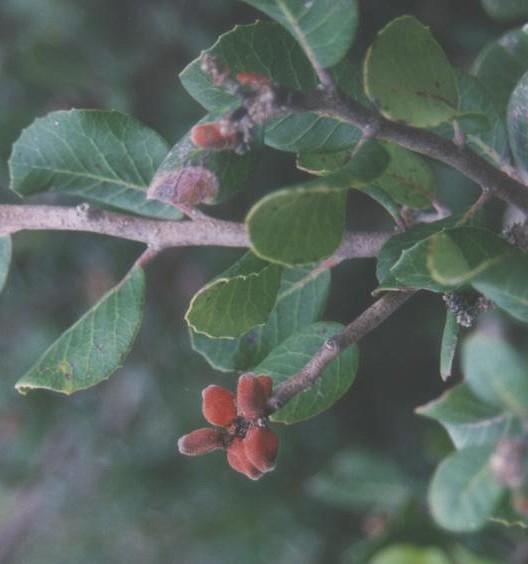- Rhus integrifolia
Taxobox
name = Rhus integrifolia

image_caption = Lemonadeberry fruit and leaves
regnum =Plantae
unranked_divisio =Angiosperms
unranked_classis =Eudicots
unranked_ordo =Rosids
ordo =Sapindales
familia =Anacardiaceae
genus = "Rhus "
species = "R. Integrifolia"
binomial = "Rhus integrifolia"
genus_authority =Carolus Linnaeus "Rhus integrifolia", also known as Lemonade Berry, Lemonadeberry, or Lemonade Sumac is a
shrub to smalltree that is one to eight meters in height, with a sprawling form. It is native to Southwestern and Pacific coastalCalifornia fromSanta Barbara County to westernRiverside County with its range extending to north-central Pacific coastalBaja California and some offshore islands like Cedros. It is a member of thechaparral plant community and is often found in canyons and on north-facing slopes below elevations of 900 meters. It often hybridizes with "Rhus ovata ".Description
The Lemonade Berry's leaves are simple (unusual in a genus where most species are trifoliate), alternating,
evergreen and leathery, ranging from two to four centimeters wide on reddish twigs; length of leaves is five to seven centimeters. Leaves are toothed with a waxy appearance above and a paler tone below. Theflowers which appear from February to May are small, clustered closely together, and may be eitherbisexual orpistil late.These fragrant flowers exhibit radial symmetry with five green
sepal s, five white to rosy-pinkpetal s, and fivestamen s. The small flowers are only six millimeters across. The ovary is superior and usually has a singleovule ; although in pistillate flowers, the stamens are small and infertile. The maturefruit of "Rhus integrifolia" is sticky, reddish, covered with hairs, and about seven to ten millimeters in diameter. The elliptical fruit presents tight clusters at the very ends of twigs.Young plants manifest smooth reddish
bark , while more mature individuals have cracked, even scaly, grayish bark with the smooth red bark displayed underneath.Twig s are rather stout and flexible, and reddish bud ends are diminutive and pointed. There is often a multi-furcate branching structure from the base of the plant. A mature plant is large andthicket -like with a sprawling arrangement.Ecology
The Lemonade Berry plant is found on dry slopes in coastal areas of southern California and especially northern Baja California; however, one colony has even been observed as far north as
Santa Cruz County . In addition to occurring on dry slopes and in canyon settings, the species sometimes is found on bluffs, as long as there is sufficient sun and absence of coastal moisture. The Lemonade Berry occurs in bothchaparral andcoastal sage scrub communities.This plant thrives on well drained soils and endures heat and windy conditions well. The species tolerates sandy as well as medium loam soils, and it can even thrive in
nutrient deficient soil. This plant tolerates mildlyacid to mildlyalkaline soils, but it can not grow in shady conditions. Propagation is by seed or by runners; in the case of seed propagationbee pollination is required of vicinity female trees growing near male trees. Lemonade Berry will not grow in proximity to thePacific Ocean where there is air with high moisture content. The fruits are enjoyed by many bird species including theroad-runner .Uses
Many plants within this genus are considered
toxic , although some reports indicate the berries of this species can be used to makelemonade flavored drinks (hence its common name). Allergic reactions may also result from skin contact withsap from some of the genera. "Rhus integrifolia" can also be used as a landscapeshrub and is suitable for hedging andespalier . The plant is vulnerable to frost, but often the plant will regrow by summer, after it appears to have died from cold. The growth habit is slow to moderate and, as a garden plant, thisspecies is quite resistant todeer . Its cultural requirements should mimic its natural environment with ample drainage and little summer water.Lemonade Berry leaves are rich in
tannin s. Even though the species is evergreen, there is some leaf fall in autumn, at which time the fallen leaves may be used as a browndye ormordant . An oil can be extracted from Lemonade Berry seeds; moreover, this oil achieves atallow consistency when left to stand. Thereafter the oil can be employed to manufacturecandle s, which burn brightly, albeit emitting a pungent scent. The wood of mature plants is dense and hard, making it prized for wood-burningfireplace kindling .References and external links
*Schmidt, Marjorie G. "Growing California
Native Plant s", University of California Press, 1980.*John H Wiersema, Blanca Leon. "World Economic Plants", CRC Press LLc (1999)
*Edward K. Balls, "Early Uses of California Plants",
University of California Press (1962)
* [http://ucjeps.berkeley.edu/cgi-bin/get_JM_treatment.pl?315,320,321 Jepson Flora Project 1993 "Rhus integrifolia"]
* [http://www.calflora.net/bloomingplants/lemonadeberry.html Photos of "Rhus integrifolia"]ee also
*
Coastal sage scrub
*Xeriscape
Wikimedia Foundation. 2010.
